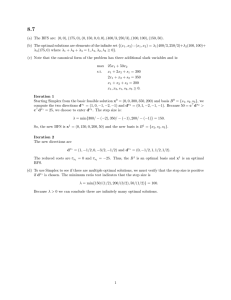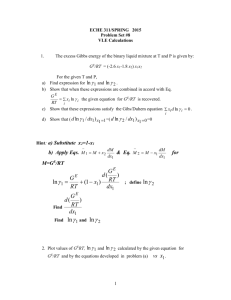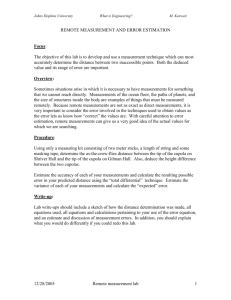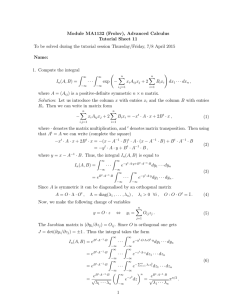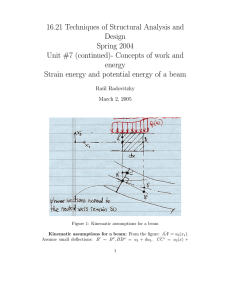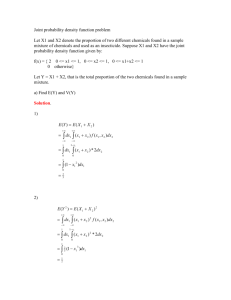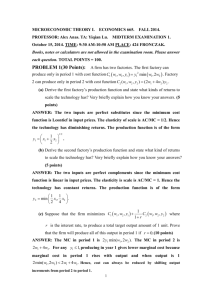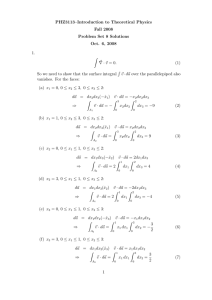Mariam Balbanyan and Vane Petrosyan
advertisement
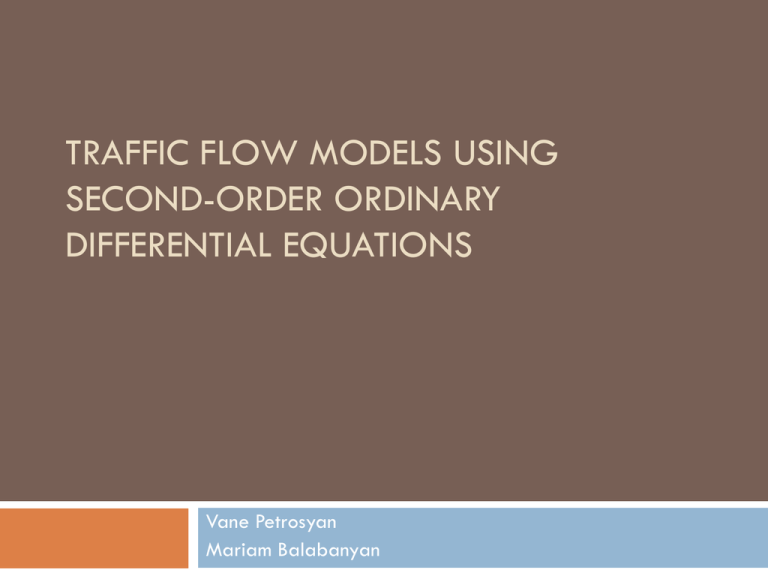
TRAFFIC FLOW MODELS USING SECOND-ORDER ORDINARY DIFFERENTIAL EQUATIONS Vane Petrosyan Mariam Balabanyan Overview • What is traffic flow? • Mathematical model of traffic flow • Application of the model to investigate stopping distances – Solving an initial value problem using a linear, nonhomogenous, constant-coefficient, second-order differential equation What is traffic flow and why is it important? Exploration of interactions between vehicles, drivers, and infrastructure in a general environment Goal of researchers: Generate a useful model Promote a road network with efficient movement of traffic and nominal traffic congestion interference Three variables: speed, flow and concentration A Mathematical Approach Microscopic models consider the behavior of individual vehicles and their motion in relation to each other Car-following model that describes how driver behavior is influenced 2 d x1 dx1 x x 1 0 2 dt dt Achieving a simplified version d x1 (t T ) ( x0 (t ) x1 (t ) d ) 2 dt 2 = sensitivity coefficient T = reaction time d = preferred separation between the two vehicles = position of the lead car x0 = position of the following car x1 Inclusion of the reaction time T makes it difficult to solve the equation (although it should be included in more realistic models) We will consider the quick thinking driver version, where T=0 2 d x1 (t ) ( x 0 (t ) x1 (t ) d ) 2 dt Our preferred separation tends to depend on our speed Short distance in slow moving traffic Greater distance in faster moving traffic Assume that the following driver’s preferred separation is dependent on her velocity dx1 (t ) d dt Substituting d into the original model, yields the simplified version d 2 x1 (t ) ( x 0 (t ) x1 (t ) d ) 2 dt d 2 x1 (t ) dx1 (t ) ( x0 (t ) x1 (t ) ) 2 dt dt d 2 x1 (t ) dx1 (t ) x0 (t ) x1 (t ) 2 dt dt d 2 x1 (t ) dx1 (t ) x1 (t ) x0 (t ) 2 dt dt So the model we will be using is… 2 d x1 dx1 x1 x0 2 dt dt = sensitivity coefficient (’s value is directly proportional to the reaction of the following driver to the relative velocity between vehicles) = preferred temporal separation (seconds) x0 = position of the lead vehicle Application to investigate stopping distances “Consider two cars driving along the road at constant velocity U m/s and separated by a distance D meters. At time t = 0 we assume the following car is x0 the following at the origin t 0, D = . How does car respond?” (McCartney 591) Becomes the following initial value problem 2 d x1 dx1 x1 D 2 dt dt dx1 0 U dt x(0) 0 First we must find the general solution of the corresponding homogenous equation. d 2 x1 dx1 2 dt dt x0 1 x1 (t ) e st d 2 x1 dx1 d 2 (e st ) d (e st ) (e st ) x1 2 2 dt dt dt dt s e se e 2 st st st (s 2 s )e st st Since e is never zero, we must have 0 (s s ) 2 From the characteristic polynomial, we can deduce the roots of the equation 2 4 r1 2 So we are given 3 cases: 2 =4, two repeated roots 2>4, two real and distinct roots 2<4, two complex roots 2 4 r2 2 Case 1: 2=4 xh c1e c2te rt rt x p DA x c1ert c2tert DA x rc1ert c2ert c2rtert x r 2c1ert rc2ert c2r 2tert d 2 x1 dx1 x1 D 2 dt dt (r 2c1ert rc2ert c2r 2tert ) (c1ert c2ert c2rtert ) (c1ert c2tert DA) D 2 DA D 2 DA D D D A 1 A 1 x c1e c2te D rt rt 1 x c1ert c2tert D Plug in the initial condition, to solve for the value of c1: x(0) 0 x(0) c1er 0 c2 0er 0 D 0 x(0) c1 D 0 c1 D Now use the initial condition given for x’(0)=U to solve for c2 dx1 0 U dt x rc1ert c2ert c2rtert x0 Drer 0 c2er 0 c2r 0er 0 U x0 Dr c2 U c2 U Dr So substituting c1 and c2 into the equation yields: x Dert (U Dr)tert D this equation can be rewritten as 2 / t x D De 2 De2t / e 2t / Ut which can then be simplified to x1 (t ) D e 2 t / (2 D U ) t D Case 2: 4 2 x1 (t ) e (1/ 2) t 1 1 2U D sinh ( 2 4)t ( 2 4) D cosh ( 2 4)t D 2 2 ( 2 4) • Has two real and distinct roots • Solution includes hyperbolic sine and cosine function Case 3: 4 2 x1 (t ) e (1/ 2 ) t 1 1 2U D sin (4 2 )t (4 2 ) D cos (4 2 )t D 2 2 (4 2 ) •2<4, two complex roots What this means physically? By making case 3 equal to D we ultimately see the following: x1 (t ) e (1/ 2 ) t 1 1 2U D sin (4 2 )t (4 2 ) D cos (4 2 )t D 2 2 (4 2 ) 0= asin(x) - bcos(x) 0= atan(x) – b tan(x)= b/a So there are infinite times where tan(x) = b/a Conclusion The mathematical model will only be physically meaningful if we restrict parameter values The driver may be quick thinking but the vehicle will infinitely collide the stopping distance is proportional to the initial velocity of the driver
